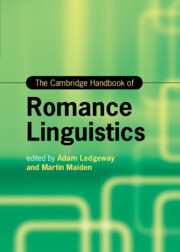Book contents
- The Cambridge Handbook of Romance Linguistics
- Cambridge Handbooks in Language and Linguistics
- The Cambridge Handbook of Romance Linguistics
- Copyright page
- Dedication
- Contents
- Figures
- Tables
- Contributors
- Abbreviations
- 1 Data, Theory, and Explanation: The View from Romance
- Part One What Is a Language?
- Part Two Phonetics and Phonology
- 5 Structure of the Syllable
- 6 Sandhi Phenomena
- 7 Effects of Stress
- 8 The Notion of the Phoneme
- 9 Typologically Exceptional Phenomena in Romance Phonology
- Part Three Morphology
- Part Four Syntax
- Part Five Semantics and Pragmatics
- Part Six Language, Society, and the Individual
- Index
- References
5 - Structure of the Syllable
from Part Two - Phonetics and Phonology
Published online by Cambridge University Press: 23 June 2022
- The Cambridge Handbook of Romance Linguistics
- Cambridge Handbooks in Language and Linguistics
- The Cambridge Handbook of Romance Linguistics
- Copyright page
- Dedication
- Contents
- Figures
- Tables
- Contributors
- Abbreviations
- 1 Data, Theory, and Explanation: The View from Romance
- Part One What Is a Language?
- Part Two Phonetics and Phonology
- 5 Structure of the Syllable
- 6 Sandhi Phenomena
- 7 Effects of Stress
- 8 The Notion of the Phoneme
- 9 Typologically Exceptional Phenomena in Romance Phonology
- Part Three Morphology
- Part Four Syntax
- Part Five Semantics and Pragmatics
- Part Six Language, Society, and the Individual
- Index
- References
Summary
In this chapter, the syllable structure of Romance languages is addressed, focusing on properties shared by all varieties as well as some specific aspects of individual varieties. The syllable template adopted is hierachical and binary, with crucial recognition of the rhyme as an intermediate constituent. The fate of vowel quantity is discussed within a framework that takes the concepts of variation and multilingualism are primary, whilst making reference to current historical sociolinguistics. In addition to the main phonological processes sensitive to syllable structure, the prosodic categories of stress and timing are also briefly illustrated. The notion of proto-Romance is criticized as not corresponding to any historically documented linguistic reality nor to a uniform system, but only to an artificially reconstructed schema. In a classification of the Romance languages, taking into account the more dynamic force of the northern Romance varieties, it is argued that a vertical axis (i.e., North–South) is better than the traditional horizontal East–West axis.
- Type
- Chapter
- Information
- The Cambridge Handbook of Romance Linguistics , pp. 183 - 208Publisher: Cambridge University PressPrint publication year: 2022
References
Selected References
- 1
- Cited by



